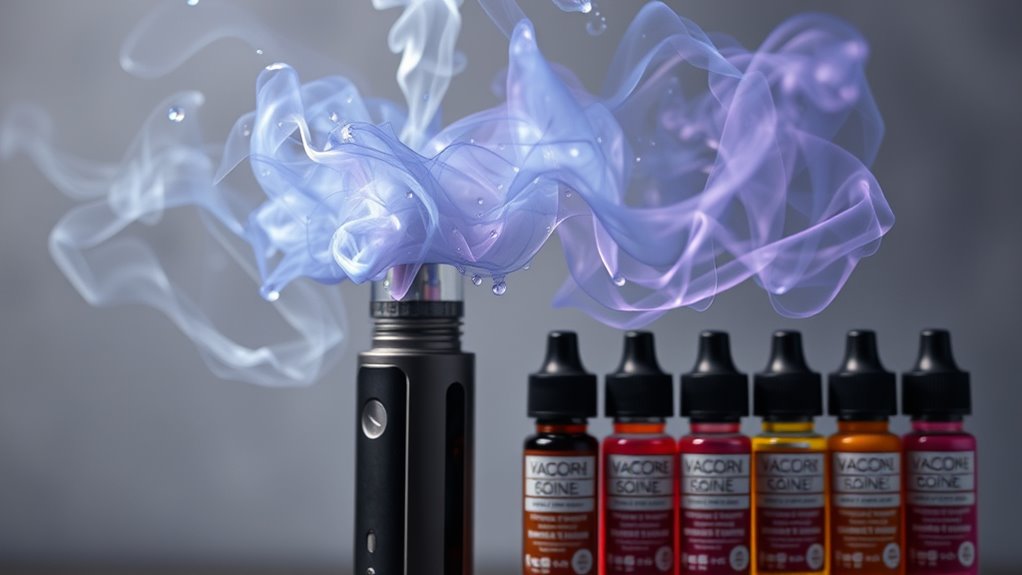Vaping exposes you to a mix of substances, including propylene glycol, vegetable glycerin, flavors, and potentially harmful chemicals. You might also inhale toxic metals like lead and nickel from vape pens. Even "nicotine-free" options can contain trace amounts of nicotine, leading to addiction. Health risks range from respiratory issues to chronic lung conditions, and there's still concern over undocumented chemicals in e-liquids. There's more to uncover about what's really in that vape cloud and its impact on your health.
Key Takeaways
- E-juices primarily contain propylene glycol and vegetable glycerin, along with various flavorings and sweeteners that may have unknown health effects.
- Vaping exposes users to toxic chemicals, including acetaldehyde and formaldehyde, which can lead to serious respiratory issues.
- Trace amounts of nicotine are often found in "nicotine-free" e-liquids, posing a risk of unintentional addiction.
- Heavy metals like lead and nickel can leach from vape pen coils, contributing to additional health risks.
- Misleading labeling obscures actual nicotine content and health risks, particularly among vulnerable populations like youth and non-tobacco users.
The Composition of E-Cigarettes

When you plunge into the world of e-cigarettes, you'll find that their composition is quite complex.
At the heart of e-juices, you'll discover key ingredients like propylene glycol, which acts as a solvent, helping to create that satisfying throat hit. Alongside it, vegetable glycerin adds a thicker texture and vapor production.
Sweeteners, such as sucralose, enhance flavor, while various flavoring agents provide the diverse tastes you encounter. Even nicotine, commonly expected, can linger in "nicotine-free" options in trace amounts.
The absence of FDA standards means you might stumble upon inconsistencies in what's actually in your vape. When heated, these liquids can also produce harmful byproducts, highlighting the importance of understanding what you're inhaling.
Understanding Vape Juice Ingredients

Understanding the ingredients in vape juice is key to grasping its impact on your health.
Grasping the ingredients in vape juice is essential for understanding its potential health impacts.
Vape pens typically contain three main components that you should be aware of:
- Propylene glycol and vegetable glycerin, which are generally safe for ingestion but whose inhalation effects remain unclear.
- Flavorings that enhance the vaping experience but may have unknown health effects.
- Sweeteners like sucralose and ethyl maltol, which add taste but can contribute to long-term health concerns.
- Potential nicotine, even in "nicotine-free" e-liquids, which can lead to unintended addiction.
- Toxic metals such as lead and nickel, likely from metal coils in your vape pen.
Being informed about these ingredients helps you make better choices for your health.
The Role of Nicotine in Vaping

Nicotine plays a significant role in vaping, primarily due to its addictive properties that can hook users quickly.
If you're an adolescent, this substance can disrupt your brain development, impacting your attention and learning abilities.
Additionally, the health risks associated with nicotine, including increased heart rate and potential tumor growth, make understanding its effects essential for anyone considering vaping.
Nicotine's Addictive Properties
Although many people view vaping as a safer alternative to smoking, it's essential to recognize that nicotine's addictive properties can easily ensnare users.
When you vape, you mightn't realize the significant risks associated with nicotine exposure. Here are some things nicotine can cause:
- Addiction, making it hard to quit vaping.
- Disruption of attention, learning, and impulse control.
- Increased likelihood of addiction to other drugs, like cocaine.
- Elevated blood pressure and heart rate, raising heart attack risk.
- Unintentional addiction from e-cigarettes that may contain trace amounts of nicotine, even if labeled nicotine-free.
Understanding these risks is important for making informed choices about vaping and its long-term effects on your health.
Effects on Brain Development
As you explore the effects of vaping on brain development, it's crucial to recognize how nicotine can considerably alter the trajectory of adolescent growth. This highly addictive substance disrupts critical processes, impacting attention, learning, and impulse control.
When you expose your brain to nicotine during these formative years, you increase the risk of addiction to other substances, such as cocaine and methamphetamines. Research shows that nicotine can lead to long-lasting effects, including mood disorders and decreased cognitive functioning.
Additionally, its impact on neural circuits may heighten your susceptibility to mental health issues later in life. Being aware of these consequences can help you make informed choices about vaping and its effects on your developing brain.
Health Risks of Nicotine
While many users underestimate the risks, the health dangers associated with nicotine in vaping are significant and far-reaching. Understanding these risks can help you make informed decisions about your choices:
- Nicotine disrupts brain development, especially in adolescents, affecting attention and learning.
- It increases susceptibility to addiction to other drugs.
- Exposure can lead to mood disorders and lower impulse control, particularly in young users.
- The American Heart Association warns that nicotine raises blood pressure and heart rate, heightening heart attack risk.
- E-liquids might contain trace amounts of nicotine even when labeled nicotine-free, which can lead to unintended addiction.
Being aware of these risks is essential for anyone considering vaping.
Prioritize your health and make informed choices about nicotine.
Potential Health Risks Associated With Vaping

Vaping may seem like a safer alternative to smoking, but it carries significant health risks that users often overlook. E-cigarettes can contain harmful toxic chemicals like acetaldehyde, formaldehyde, and acrolein, all linked to cancer and lung damage.
Without FDA regulations, the composition of e-cigarette products can vary widely, exposing you to unknown health risks. Research shows that vaping releases ultrafine particles that penetrate deep into your lungs, worsening respiratory issues and overall lung health.
Additionally, heavy metals like lead and nickel can leach into the aerosol, adding to health concerns. The CDC has reported over 450 cases of vaping-related lung illnesses, highlighting the urgent need for awareness and caution about these products.
Flavorings and Their Safety Concerns

When you choose a flavored vape juice, you mightn't consider the safety of those flavoring ingredients.
Many compounds are safe to eat, but inhaling them can pose serious health risks, like respiratory issues.
Plus, the lack of regulation means you could be exposed to harmful substances without even knowing it.
Flavoring Ingredients Overview
As you explore the world of e-cigarette flavorings, it's essential to understand the diverse chemical compounds that create them and the safety concerns they raise.
While flavoring ingredients can enhance your vaping experience, their long-term effects when inhaled are uncertain. Here are some key points to reflect on:
- Hundreds of flavoring options exist, raising safety questions.
- Common carrier fluids like propylene glycol are generally safe for consumption, but not well-studied for inhalation.
- Some flavoring agents, like diacetyl, are linked to severe lung conditions.
- Harmful compounds can form during the heating process.
- The safety of ingesting flavorings doesn't guarantee their safety when inhaled.
- Additionally, essential oils used for flavoring may also pose risks if they are not properly diluted before being vaporized.
Being informed about these aspects can help you make better choices in your vaping journey.
Inhalation Safety Risks
While many enjoy the flavors that enhance their vaping experience, it's crucial to recognize the potential inhalation safety risks associated with these additives.
The flavorings in vape juice often contain chemical compounds that haven't been thoroughly studied for their effects on your lungs. Some, like diacetyl, are linked to serious lung illnesses, including popcorn lung, raising significant health concerns.
Even common carrier fluids, typically seen as safe for consumption, may pose unknown risks when inhaled. Cooling agents added to enhance flavor might mask nicotine's harshness, leading to increased consumption and unintentional addiction.
Additionally, misleading labeling can leave you unaware of the actual nicotine content, further complicating the health problems associated with vaping flavored products.
The Presence of Toxic Metals in E-Cigarettes

E-cigarettes might seem like a safer alternative to traditional smoking, but they can expose users to toxic metals that pose serious health risks.
E-cigarettes may appear safer, yet they can release toxic metals that threaten your health.
When e-liquid is heated with metal coils, these toxic metals can leach into the vapor. A 2018 study from Johns Hopkins highlighted alarming levels of metals, including:
- Chromium
- Nickel
- Lead
- Manganese
- Zinc
These heavy metals can lead to significant health issues, like respiratory problems and long-term lung damage.
The presence of toxic metals in e-cigarettes is particularly concerning, as inhaling them can cause various health complications. Regular exposure may result in cumulative effects, further compounding the risks associated with vaping.
It's essential to be aware of what's in your vape cloud.
The Unknown: Undocumented Chemicals in Vapes

Despite the perception that vaping is a safer choice, many users remain unaware of the undocumented chemicals lurking in e-liquids. These chemicals can include toxic compounds formed when heating e-liquids, and concerns over contaminants from counterfeit products are growing. The FDA is actively testing samples from patients with vaping-related illnesses to pinpoint harmful substances, but no single culprit has been identified consistently.
| Potential Undocumented Chemicals | Health Risks |
|---|---|
| Pesticides | Respiratory issues |
| Unidentified heating byproducts | Long-term health effects |
| Contaminants from counterfeit vapes | Increased illness risk |
| THC and cannabis-based substances | Varying respiratory impacts |
Being informed about these undocumented chemicals is essential for your health.
The Impact of Vaping on Lung Health

Vaping introduces harmful substances directly into your lungs, which can lead to serious respiratory issues.
When you inhale from vapes, you're exposing yourself to a range of toxic chemicals that can cause long-term damage.
Consider these risks:
- Ultrafine particles and toxins can damage lung tissue.
- Chemicals like acrolein and diacetyl may lead to irreversible lung conditions.
- Heavy metals such as lead and nickel are found in e-cigarette aerosols.
- Over 450 cases of lung illness linked to vaping were reported by the CDC in 2019.
- Regular e-cigarette use can result in chronic respiratory symptoms and increased risk of infections.
It's vital to understand how vaping affects your lung health and make informed choices.
Public Health Warnings and Recommendations

As awareness grows about the health risks associated with vaping, public health officials are issuing strong warnings and recommendations to protect vulnerable populations.
They strongly advise against purchasing vaping products from street vendors, as these may contain harmful contaminants and unregulated ingredients.
E-cigarette products shouldn't be used by youth, young adults, pregnant women, or non-tobacco users to minimize exposure to nicotine and other toxic substances.
Public health officials highlight the dangers of vaping THC products, which have been linked to severe respiratory illnesses.
Ongoing monitoring and research are essential to fully understand vaping's long-term health effects.
Public health campaigns aim to raise awareness about these risks, encouraging informed decisions among potential users.
Stay informed and prioritize your health.
Resources for Educating Yourself About Vaping

Understanding the complexities of vaping is essential, especially as misinformation can easily spread.
To help you make informed choices, here are some valuable resources for educating yourself about vaping:
- CDC: Offers extensive information on health effects and risks of e-cigarettes.
- U.S. Surgeon General: Highlights specific risks linked to e-cigarette use among young adults.
- Teens Health: Provides tailored resources for young individuals regarding e-cigarette implications.
- American Lung Association: Features quitting resources for those looking to stop vaping.
- Public Health Campaigns: Raise awareness about vaping dangers and promote ongoing education.
Frequently Asked Questions
What Does a Vape Cloud Contain?
A vape cloud contains aerosolized particles that come from e-liquids. When you vape, you inhale propylene glycol, vegetable glycerin, flavorings, and nicotine.
However, it's important to know that these e-liquids can also have harmful chemicals like formaldehyde and acrolein, which are linked to serious health issues.
Plus, the vapor may include toxic metals from the heating coils, and even "nicotine-free" liquids can have trace amounts of nicotine you mightn't expect.
Is Propylene Glycol in Vapes Bad for You?
Yes, propylene glycol in vapes can be bad for you.
While it's generally safe in food, inhaling it may cause respiratory irritation and other lung issues. When heated, it can produce harmful byproducts like acrolein, which could damage your lungs.
If you have asthma or other respiratory conditions, using products containing propylene glycol might worsen your symptoms.
Even e-liquids labeled as "propylene glycol-free" can contain trace amounts, leading to unintentional exposure.
What Chemicals Are in Vape Vapour?
You might think vaping's harmless, but it's crucial to know what's in that vapor.
Vapes typically contain propylene glycol and vegetable glycerin, which serve as the base for flavors and nicotine. However, you could also inhale toxic metals like lead and harmful chemicals like formaldehyde.
Even e-liquids labeled nicotine-free can have trace amounts of nicotine. Understanding these chemicals can help you make informed choices about your vaping experience.
Are Vape Clouds Just Harmless Water Vapor?
No, vape clouds aren't just harmless water vapor.
When you exhale, you're releasing a mix of chemicals, including nicotine and flavorings, which can turn toxic when heated. These clouds contain ultrafine particles that can deeply penetrate your lungs, posing potential health risks.
Additionally, harmful substances like formaldehyde and heavy metals may be present, raising concerns about long-term effects on your respiratory health.
It's important to understand what you're inhaling.
Conclusion
In the whirlwind of vaping's popularity, it's essential to stay informed about what's in those clouds. Just like a detective piecing together clues, you need to scrutinize the ingredients, from nicotine to flavorings, and understand the potential risks. Remember, the allure of vape might feel like a futuristic escape, but the reality could be more like a smoke-filled room from the past—cloudy and uncertain. Stay educated, and always prioritize your health over trends.









